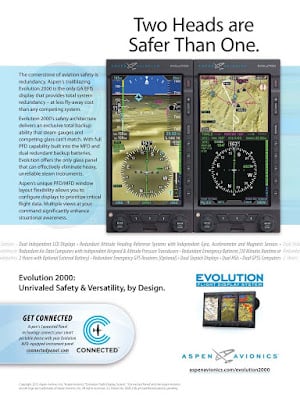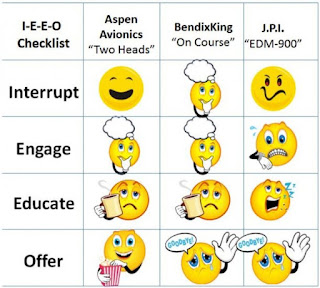Checklists are found everywhere in the aviation world. Thus, it should come as no surprise that advertising in the aviation world can be significantly enhanced and improved with the use of a checklist. The I-E-E-O (Interrupt, Engage, Educate, and Offer) Checklist as illustrated in this example from Aspen Avionics and their recent “Two Heads Are Safer” advertisement clearly highlights the value of the checklist for improving advertisements.

The Aspen advertisement makes efficient use of white space with a clean design. It interrupts with a beauty shot of the product itself along with a headline that has a familiar ring to it. And while the interrupt could be stronger, the “Two Heads are Safer than One” headline positioned directly above the dual displays of the featured product is just intriguing enough to catch the attention of a reader thinking about a potential avionics upgrade. So, Aspen successfully checks off the interrupt stage of our I-E-E-O advertising checklist.
Next, Aspen’s engage statement is the first paragraph of text in their advertisement. In reminding us “the cornerstone of aviation safety is redundancy” they nicely link the interrupt headline and product shot with the engage step of the checklist.
However, as they move into the EDUCATE phase, Aspen’s diligence with the I-E-E-O checklist begins to slip. First we learn that their product is the only GA EFIS display providing “total system redundancy” at “less fly-away cost” than the competition.
Additionally, they add two seemingly important and relevant issues when they point out that their product can “effectively eliminate heavy, unreliable steam instruments” and provide “window layout flexibility” allowing the user to customize the product to “prioritize critical flight data.”
This is not a bad start to the educate/teaching phase; they have raised four relevant issues redundancy, cost, reliability, and customization. The problem is they explain or educate only the tiniest bit about the redundancy and customization elements. Further, they leave no educational proof as to how their solution delivers on the cost or reliability promises.
In advertising, if you are going to raise issues with a reader, you must provide proof points or risk being seen as “all talk, no action” instead of a seasoned voice of reason with which a reader will spend their hard-earned money. A better approach would be to narrow the issues and expound upon them one by one. Better yet, change the design of the advertisement to provide more space for details about multiple issues, so the reader comes to better understand Aspen’s unique product offering.
Where Aspen misses the mark though, is at the OFFER stage of the I-E-E-O checklist. It’s here that a low risk offer should be made to motivate the reader to take further action; just reading an advertisement will not a sale make. After all, if you’ve managed to Interrupt, Engage, and Educate a reader with any success, the next logical step is to Offer the reader an action that will move them closer to a purchase decision. If not, then the advertisement is just a noisy statement piece instead of a tool meant to ring the cash register.
So, while Aspen’s advertisement started out boldly enough, it finishes with a mere whimper by not making an offer to the interested reader. Oh yes, there is a web address in the lower right hand corner that links directly to an information page about the product but it is listed in tiny type. Even worse, there is not an invitation, direction, or promise surrounding the link other than the company’s logo.
On the positive side, Aspen is using a “live-link”, so readers viewing the advertisement on a tablet, phone, or computer might touch the link and be delivered to an extensive, product web page that is well made. Imagine how many more readers would experience that extra information if an offer hinted at the glorious detail behind the “live-link”. Closing an advertisement without an offer is similar to missing the fuel level part of the pre-flight checklist and then wondering why you’re flying on empty.
One more thing, almost as an afterthought, Aspen’s “Get Connected” effort is included in the advertisement. This is an intriguing program and a key element that can be used to set Aspen apart from the competition. However, by including it in the layout of this advertisement, the reader is left wondering how the “Get Connected” story, links with the main “Two Heads are Safer” story. It would prove far more effective to integrate the message of “Get Connected” into the Engage and Educate step or keep it out of the advertisement completely. Usually, when a company places two, non-integrated elements in an advertisement, it is done to satisfy internal company politics trying to economize around a budget, instead of thinking about the reader’s interest and how best to make a sale.
In summary, the Aspen “Two Heads are Safer” advertisement starts out strongly enough in the Interrupt and Engage stages of the I-E-E-O checklist, but then slides slowly down the success stack toward a whimper of a landing by cheating through the Educate part of the checklist and blowing off the Offer stage completely.
###
 Greg G
:
Mar 1, 2014 1:53:00 PM
Greg G
:
Mar 1, 2014 1:53:00 PM

 The Aspen advertisement makes efficient use of white space with a clean design. It interrupts with a beauty shot of the product itself along with a headline that has a familiar ring to it. And while the interrupt could be stronger, the “Two Heads are Safer than One” headline positioned directly above the dual displays of the featured product is just intriguing enough to catch the attention of a reader thinking about a potential avionics upgrade. So, Aspen successfully checks off the interrupt stage of our I-E-E-O advertising checklist.
The Aspen advertisement makes efficient use of white space with a clean design. It interrupts with a beauty shot of the product itself along with a headline that has a familiar ring to it. And while the interrupt could be stronger, the “Two Heads are Safer than One” headline positioned directly above the dual displays of the featured product is just intriguing enough to catch the attention of a reader thinking about a potential avionics upgrade. So, Aspen successfully checks off the interrupt stage of our I-E-E-O advertising checklist.

